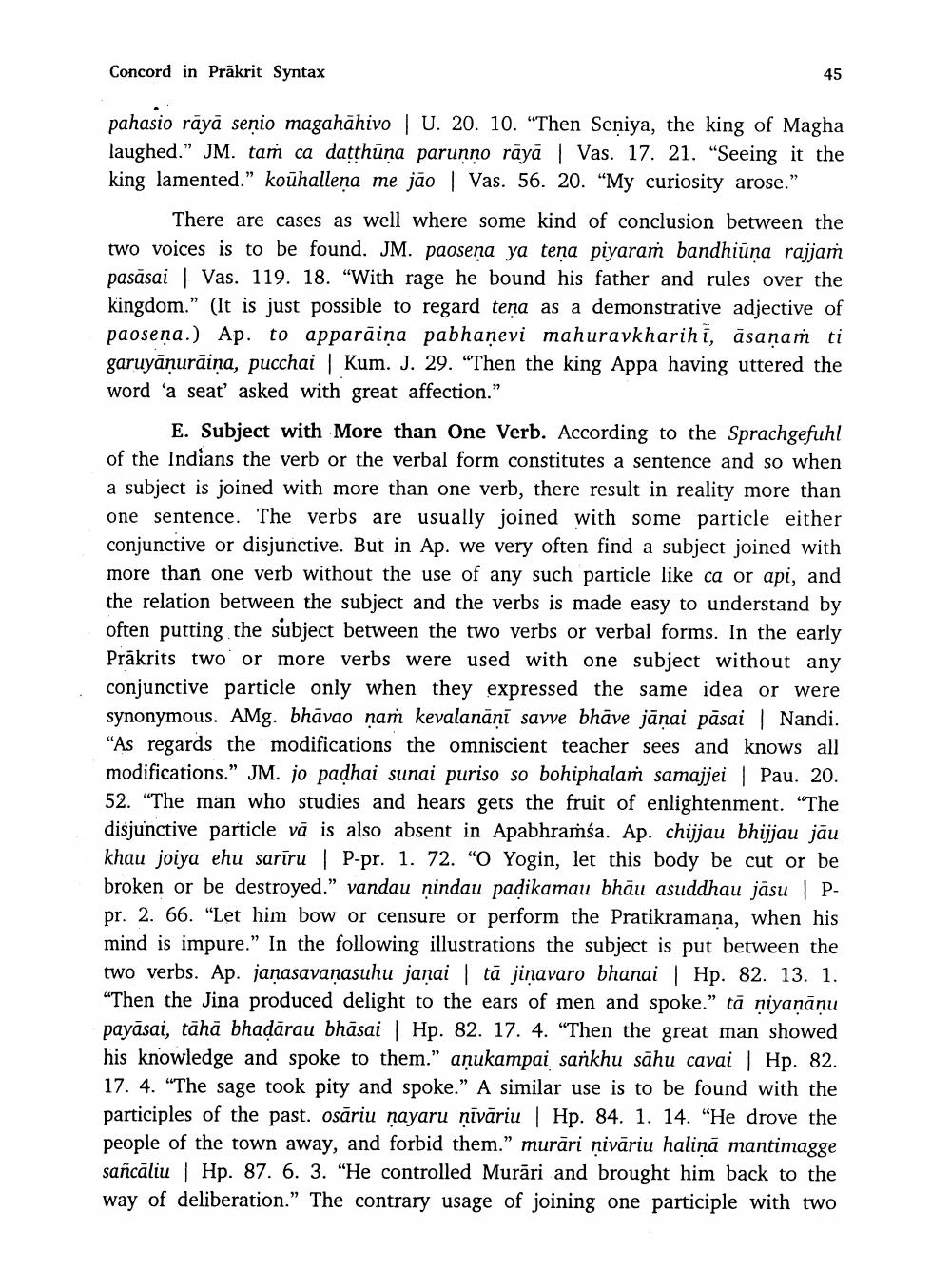________________
Concord in Prākrit Syntax
45
pahasio rāyā senio magahāhivo | U. 20. 10. “Then Seniya, the king of Magha laughed.” JM. tam ca datthūna parunno rāyā | Vas. 17. 21. “Seeing it the king lamented." koühallena me jão | Vas. 56. 20. "My curiosity arose."
There are cases as well where some kind of conclusion between the two voices is to be found. JM. paosena ya tena piyaram bandhiūna rajjam pasāsai | Vas. 119. 18. "With rage he bound his father and rules over the kingdom.” (It is just possible to regard tena as a demonstrative adjective of paoseņa.) Ap. to apparāiņa pabhanevi mahuravkharihi, asanam ti garuyanurāina, pucchai | Kum. J. 29. "Then the king Appa having uttered the word 'a seat' asked with great affection.”
E. Subject with More than One Verb. According to the Sprachgefuhl of the Indians the verb or the verbal form constitutes a sentence and so when a subject is joined with more than one verb, there result in reality more than one sentence. The verbs are usually joined with some particle either conjunctive or disjunctive. But in Ap. we very often find a subject joined with more than one verb without the use of any such particle like ca or api, and the relation between the subject and the verbs is made easy to understand by often putting the subject between the two verbs or verbal forms. In the early Prākrits two or more verbs were used with one subject without any conjunctive particle only when they expressed the same idea or were synonymous. AMg. bhāvao nam kevalanāni savve bhāve jānai pāsai Nandi. “As regards the modifications the omniscient teacher sees and knows all modifications.” JM. jo padhai sunai puriso so bohiphalaṁ samajjei | Pau. 20. 52. "The man who studies and hears gets the fruit of enlightenment. "The disjunctive particle vā is also absent in Apabhraṁsa. Ap. chijjau bhijjau jāu khau joiya ehu sarīru | P-pr. 1. 72. “O Yogin, let this body be cut or be broken or be destroyed.” vandau nindau padikamau bhāu asuddhau jāsu | Ppr. 2. 66. “Let him bow or censure or perform the Pratikramana, when his mind is impure.” In the following illustrations the subject is put between the two verbs. Ap. janasavaņasuhu janai | tā jinavaro bhanai | Hp. 82. 13. 1. "Then the Jina produced delight to the ears of men and spoke.” tā niyaņāņu payāsai, tāhā bhadārau bhāsai Hp. 82. 17. 4. “Then the great man showed his knowledge and spoke to them.” anukampai sarkhu sāhu cavai | Hp. 82. 17. 4. "The sage took pity and spoke.” A similar use is to be found with the participles of the past. osāriu nayaru ņīvāriu | Hp. 84. 1. 14. “He drove the people of the town away, and forbid them.” murāri nivāriu halinā mantimagge sañcāliu | Hp. 87. 6. 3. "He controlled Murāri and brought him back to the way of deliberation.” The contrary usage of joining one participle with two




